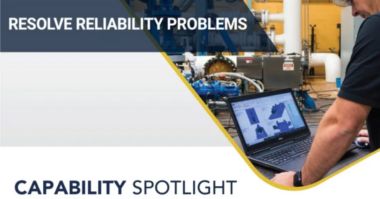Maintenance is a popular buzzword in many asset-intensive industries, and rightly so. The very nature of its operation requires periodic functional checks, servicing, repair and replacement, and other measures that fit under the umbrella of maintenance.
The aim of performing maintenance is to sustain the reliable performance of machines and equipment that are used and relied upon daily. By doing so, businesses can avoid unplanned asset failure, which can cost 10 times more than it does to implement a working maintenance plan.
But, as effective as these measures are, they’re still one-dimensional and manual. Meaning they don’t offer the holistic understanding required to prevent asset failure and instead rely on a more reactive approach.
This is where rootcause analysis (RCA) is key.
RCA was created to generate a comprehensive understanding of the symptoms and root causes of problems that happen to assets. RCA is a proven method that prevents repetitive asset breakdown and enhances asset reliability to improve and prolong the operational stage of an asset’s life cycle.
So, What Is Root Cause Analysis?
Root Cause Analysis is a bottom-up comprehensive troubleshooting technique that identifies and controls the systemic causes of maintenance problems long before they occur.
A simpler way to understand what RCA is is to imagine you’re conducting a routine inspection on one of your most used machines and notice a slight malfunction. Of course, the first thing you’ll do is react and request a repair from your engineers.
A few weeks later, the same issue arises, and you go through the same process again, such that it becomes an almost endless cycle. You’ll agree that this wouldbecome tiring as it costs you and takes a toll on operational productivity. So, instead of continuously staying in a tiring firefighting mode on your most used asset, you have to find a lasting solution to the problem. This is where Root Cause Analysis comes into play.
It involves using a wide range of techniques, tools, and approaches to uncover foundational causes of problems to eliminate them and prevent them from recurring.
It rides on the belief that one needs to engage the problem beyond the surface level to solve and prevent it from recurring. If that’s achieved, then there’s an assurance of multi-level operational efficiency that derives growth and increased productivity.
How Does Root Cause Analysis Work?
Root Cause Analysis works on the assumption that all systems and events have causal relationships. In other words, all systems and events in an asset are related because an action in one area is evident in another area, another action in another area is seen in another area, and so on.
So, once a problem occurs, RCA traces all actions from where it’s noticeable to where it started.
During this gradual evaluation, the RCA tool discovers the physical causes of the problem involving failures of tangible components of the machine; the human causes involving actions and inactions that led to the physical causes of the problem; and lastly, organisational causes which involve lack of provision in monitoring both physical and human causes of the problem.
RCA evaluates all the above to identify negative patterns, unseen flaws, and inefficiencies. A mere look at this reveals that once the evaluation is complete, more than one root cause is generated and acted upon for resolution.
The Process of Executing Root Cause Analysis
Root Cause Analysis helps to identify the “what, why, and how” of all problems it is applied to. This is done through specific processes, which include:
1. Problem Recognition Problem recognition is the first process involved in conducting a Root Cause Analysis. It involves a simple observation when an asset breaks down and the definition of the fault to explore possible solutions.
You’ll agree that if you don’t first identify the problem, it would be difficult to determine what it is and how it can be resolved.
2. Data Collection After determining the problem, the next step is to collect asset data and analytics that grounds theproblems. The data you’ll collect will enclose details about the issue, how long it has existed, and the impact on the asset it affected.
This step is crucial as it involves a critical analysis of the problem initially observed, identifying the causativeagents of the problems using charts, diagrams, ‘5 whys’, and a drill down till the root cause is discovered. Failure to do this may cause incorrect data to be generated, ultimately leading to poor decision-making.
3. Recommendation and Implementation of Solutions Once you’ve made sense of the root causes of the problems, open up for recommendations on how to prevent further occurrence of the problem. After this, you generate practical solutions and determine how they would be implemented.
While this may seem like all of it, you must also explore the possible problems of implementing a method before final execution. Once all these are determined, you can repeat the same process for other assets with similar issues within or outside that location.
4 Benefits of Using the Root Cause Analysis Method
The significant benefits of using RCA include an end to recurring problems and a transition from short-term solutions to long-term solutions for asset breakdown. Other benefits include:
1. Cost Reduction Asset maintenance incurs a sizable cost on its own to tolerate recurring maintenance. So a way to avoid hurting the operations budget is to use a longstanding solution like RCA that eliminates emergency maintenance and reduces the cost of such maintenance.Reactive maintenance has a 40% higher cost expectancy when compared to proactive methods such as RCA and preventive maintenance.
2. Enhanced Productivity When you conduct RCA on your asset, they leave them in a healthy condition for an extended period, which brings consistent productivity for a longer time. This doesn’t only improve profitability; it also fosters the pursuit of predefined business objectives.
3. Task Prioritisation RCA allows organisations to prioritise tasks by maintaining crucial assets to enhance uptime and deliver high-value tasks. Similarly, it helps maintain less critical assets to meet operational and regulatory requirements.
4. Improved Safety Whether your assets are fixed or movable, you must ensure they don’t hamper the safety of your employees. RCA is an effective way to ensure a safe working environment and enhance your employees’ confidence in the space they discharge their duties.
How RCA Reduces Reactive Maintenance and Promotes Preventive Maintenance
Root Cause Analysis is a highly effective maintenance technique built to eliminate reactive maintenance and institute a preventive approach to maintenance. It offers a predictive and proactive approach to asset maintenance activities and creates a solution plan for future breakdowns.
This automatically reduces reactive maintenance because potential problems are identified and rectified long before they occur. This helps to:
●Reduce unplanned downtime of mission-critical machinery and equipment
●Improve asset reliability
●Lessen the need for expensive corrective and emergency repairs
●Increase safety in the workplace
Additionally, RCA helps eliminate organisational causes of asset breakdown by establishing plans to prioritise when using such assets.





Comments